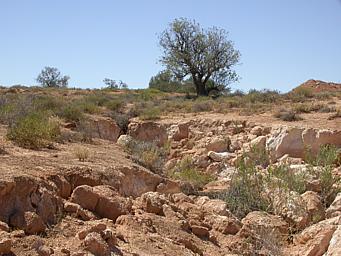Rabbits in Australia
|
|
Wild_rabbit.jpg
In their natural environment and in captivity, rabbits are a benign, even useful species. However, when introduced by humans into environments that do not have natural defences against them, rabbits can cause enormous damage. Perhaps the most well-known example of this is the continent of Australia. In Australia, the European Rabbit is the most serious mammalian pest, an invasive species, and is responsible for the extinction of about as many native animals as the fox. Annually, rabbits cause millions of dollars of damage to agriculture.
| Contents |
Introduction of rabbits to Australia
They were originally introduced to Australia by the First Fleet in 1788, but the current major infestation appears to be the result of 24 wild rabbits released by Thomas Austin on his Barwon Heads property in 1859 for hunting purposes. Many other farms released their rabbits into the wild after Austin.
The problem of rabbit infestation is documented by Roman geographer Strabo, who gave the following account of feral rabbits introduced in the 2nd century BC into the Balearic Islands ("Gymnesiae"):
- "No injurious animal can easily be found in the Gymnesiae. For even the rabbits there, it is said, are not native, but the stock sprang from a male and female brought over by some person from the opposite mainland [of coastal Spain]; and this stock was, for a fact, so numerous at first, that they even overturned houses and trees by burrowing beneath them..." (III.5.2)
Rabbits are extremely prolific creatures, and as Australia had no natural predators that could keep the rabbit population in check, rabbits spread rapidly across the southern parts of the continent.
Within ten years of the 1859 introduction, the original 24 rabbits had multiplied so much that 2 million a year could be shot or trapped without having any noticeable effect on the population size. Rabbits reached the New South Wales border in 1870. Fifteen years later they entered Queensland, and by 1900 the rabbit was firmly established nationwide. It was the fastest spread ever recorded of any mammal anywhere in the world. Today rabbits are entrenched in the southern and central areas of the continent, with scattered populations in the northern deserts.
Effects on Australia's ecology
The effect on the ecology of Australia was devastating. One eighth of all mammalian species in Australia are now extinct (rabbits are the most significant known factor), and the loss of plant species is unknown even at this time.
Huge areas of land in Australia have been cleared by tractors pulling chains in order to prepare the land for agricultural purposes. The rabbits easily thrived on the cleared land, and their population boomed.
Rabbits are also responsible for serious erosion problems as they eat native plants which would have retained soil. Some of this erosion may also be the result of settlers clearing much of Australia's land for farming and housing.
Rabbit control measures
Currently, land owners are legally bound to control rabbits in order to reduce their impact on the land and local flora and fauna. In fact, rabbit eradication campaigns have become a popular pastime in the country's rural areas. Control measures generally include killing them, fertility control, or exclusion, but most of these rabbit control measures have had an insignificant impact on the rabbit population.
Conventional control measures
A number of methods for reducing rabbit numbers have been applied. Shooting rabbits is reasonably common, and two main techniques are used; either twilight stalking with a rifle (usually using a .22 LR cartridge), or flushing them out and shooting a running rabbit with a shotgun. Sometimes the technique of spotlighting is used.
Poisoning is also often used, with grain laced with 1080, or, where risk to other animals is greater, the more rodent-specific pindone. Poisoning is probably the most widely-used of the conventional techniques, as it requires the least effort. The disadvantage is that the rabbit cannot be used as food for either humans or pets afterward.
Another technique used occasionally is hunting using ferrets, where nets are placed over burrow exits and the ferrets deployed to chase the rabbits into the nets. This is more a hunting activity than a serious control method.
All of these techniques are limited to working only in settled areas and are quite labor-intensive.
Biological measures
Releasing rabbit-borne diseases has proven somewhat successful in controlling the population of rabbits in Australia. In 1950, Myxomatosis was released into the rabbit population which caused the rabbit population to drop from an estimated 600 million to around 100 million. Genetic resistance in the remaining rabbits allowed the population to recover to 200-300 million by 1991.
To combat this trend, Commonwealth Scientific and Industrial Research Organisation (CSIRO) scientists released rabbit calicivirus (also known as Rabbit Hemorrhagic Disease or RHD) in 1996. However, it was not as successful as myxomatosis in part because it was estimated to have been fatal to only 65% of infected rabbits, as opposed to 99% for myxomatosis.
The Australian Government refuses to legalise a vaccine to protect pet rabbits against Myxomatosis (a legal vaccine exists in Australia for RHD), and thousands of pet rabbit owners in Australia suffer losses of their pet rabbits each year. There is no cure for either Myxomatosis or RHD, and many affected pets are euthanized.
External links
Rabbit Information Service - a site opposing the use of rabbit calicivirus in Australia (http://members.iinet.net.au/~rabbit/rabbit.htm)

